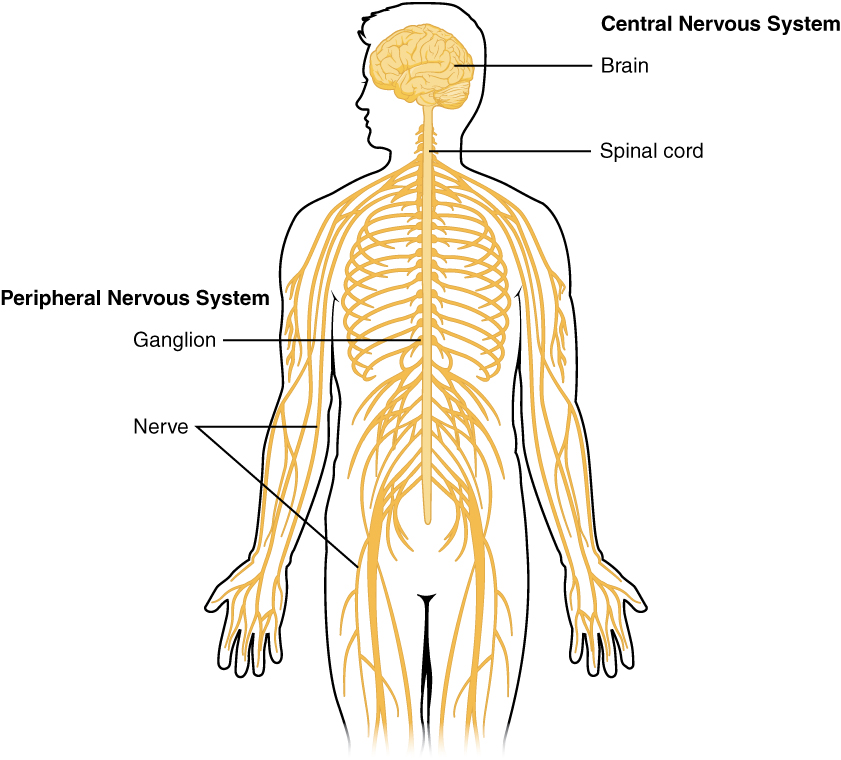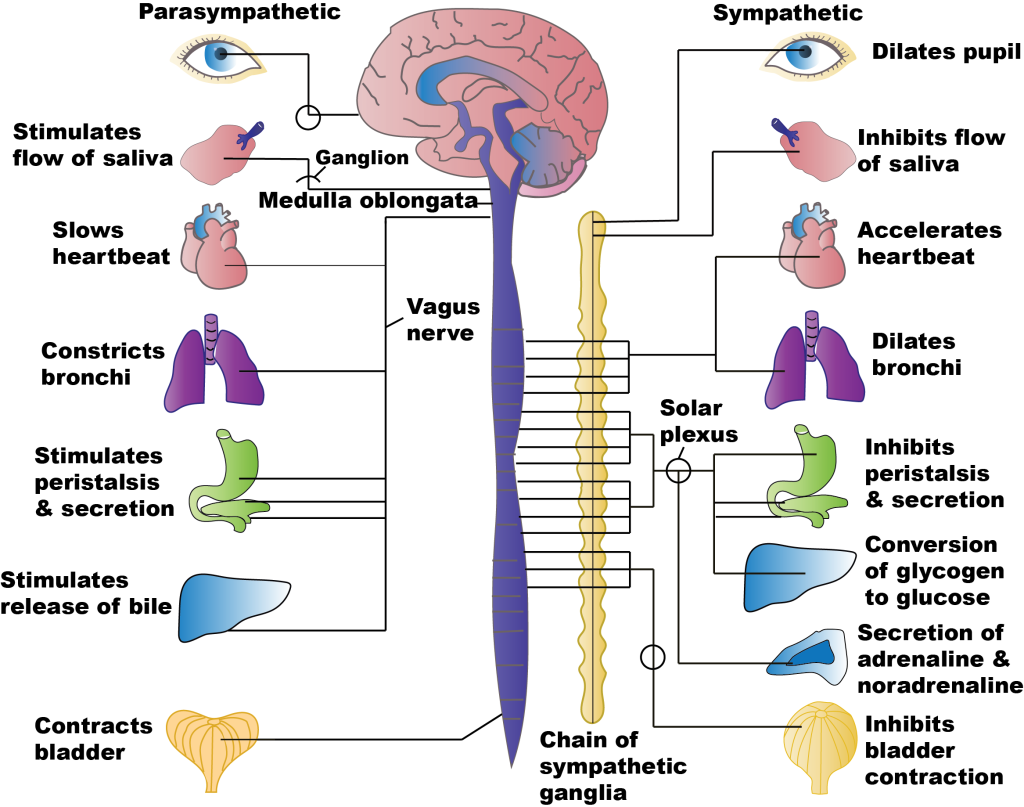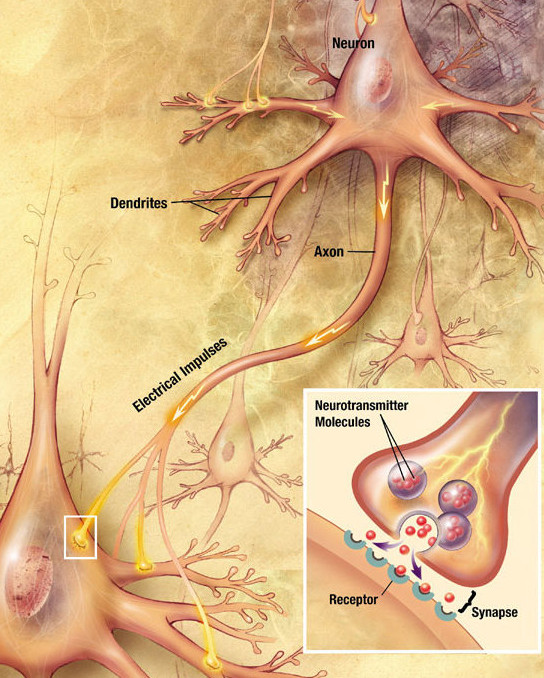6.2 Review of the Nervous System
Understanding the anatomy and physiology of the nervous system is essential to understanding how psychotropic medications work. The nervous system regulates both conscious and unconscious processes in the body, including thought, movement, sensation, and automatic functions like heart rate and digestion. It is divided into two main parts: the central nervous system (CNS) and the peripheral nervous system (PNS). See Figure 6.1[1] for an illustration of the central and peripheral nervous systems.

The Central Nervous System (CNS)
The CNS consists of the brain and spinal cord, serving as the primary control center for processing and integrating information. The brain regulates cognition, emotions, and autonomic functions, while the spinal cord transmits signals between the brain and the rest of the body.
The brain’s complex systems also regulate key functions such as pain perception, reward processing, and emotional regulation. For example, the opioid system in the brain plays a crucial role in pain and reward and is integral to understanding addiction and the effects of psychoactive substances. This system, along with other neurotransmitter systems such as dopamine and serotonin, is central to many mental health disorders. These neurotransmitters act as messengers, influencing mood, behavior, and thought processes, and are frequently targeted by psychotropic medications.
We’ll explore these systems and their role in mental health disorders and medication therapy in more detail later.
The Peripheral Nervous System (PNS)
The PNS consists of sensory and motor neurons that connect the CNS to the rest of the body, playing a vital role in both voluntary and involuntary processes. It functions as a bridge, relaying information between the CNS and various organs, muscles, and sensory receptors.
- Sensory neurons detect stimuli from the environment (such as light, sound, and temperature) and send signals to the brain, creating conscious perception of these stimuli.
- Motor neurons transmit signals from the brain to muscles and glands, initiating voluntary movements and autonomic responses.
Motor neurons are further divided into the following:
- The somatic nervous system, which controls voluntary muscle movements, such as those required for walking, talking, and writing.
- The autonomic nervous system (ANS), which regulates involuntary functions such as heart rate, digestion, and respiratory rate, maintaining homeostasis in the body.
The peripheral nervous system consists of sensory neurons and motor neurons. Sensory neurons sense the environment and conduct signals to the brain that become a person’s conscious perception of that stimulus. This conscious perception may lead to a motor response that is conducted from the brain to the peripheral nervous system via motor neurons. Motor neurons are part of the somatic nervous system that stimulates voluntary movement of muscles and the autonomic nervous system that controls involuntary responses.
Sympathetic and Parasympathetic Nervous System
The autonomic nervous system is further subdivided into the sympathetic nervous system (SNS) and the parasympathetic nervous system (PNS), each with distinct and complementary functions:
- Sympathetic Nervous System (SNS): The SNS is often associated with the “fight-or-flight” response. When activated, it prepares the body for stress or emergency situations by increasing heart rate, constricting blood vessels to raise blood pressure, and causing bronchodilation (widening of the airways) to increase oxygen intake.
- Parasympathetic Nervous System (PNS): In contrast, the PNS supports “rest-and-digest” functions, helping the body conserve energy and maintain a state of relaxation. PNS activation slows the heart rate, dilates blood vessels to reduce blood pressure, and promotes bronchoconstriction (narrowing of the airways).
The body maintains homeostasis by balancing the stimulation of the SNS and PNS. For example, during physical activity, the SNS dominates to help the body respond to the increased demand for energy, while during rest, the PNS takes over to return the body to a state of calm and relaxation.
See Figure 6.2[2] to compare the effects of PNS and SNS stimulation on target organs.

SNS Receptors
SNS receptors include Alpha-1, Alpha-2, Beta-1, and Beta-2 receptors, which are stimulated by epinephrine and norepinephrine. Medications that activate these receptors are referred to as adrenergic agonists because they mimic the effects of the body’s natural SNS response. For example, stimulants like methylphenidate are adrenergic agonists used to treat attention deficit hyperactivity disorder (ADHD). Conversely, adrenergic antagonists block SNS receptors. For example, propranolol is a Beta-2 antagonist used to manage the physical symptoms of severe anxiety (e.g., trembling, rapid heartbeat, and sweating).
PNS Receptors
PNS receptors include nicotinic and muscarinic receptors that are stimulated by acetylcholine (ACh). Drugs that stimulate nicotinic and muscarinic receptors are called cholinergics. For example, nicotine in tobacco products stimulates nicotinic receptors. Stimulation of muscarinic receptors primarily causes smooth muscle contraction. An example of a muscarinic agonist is bethanechol used to treat urinary retention by increasing the tone of the detrusor muscle to increase bladder emptying.[3] Drugs that block the effects of PNS receptors are called anticholinergics. For example, benztropine is an anticholinergic used to treat muscle spasms associated with extrapyramidal symptoms from antipsychotic medications.[4] Many psychotropic medications cause anticholinergic adverse effects that can be especially hazardous for older adults. SLUDGE is a mnemonic for anticholinergic side effects: Salivation decreased, Lacrimation decreased, Urinary retention, Drowsiness/dizziness, GI upset, and Eyes (blurred vision/dry eyes). See Figure 6.3[5] for an illustration of the “SLUDGE” effects caused by anticholinergics.

Opioid System
The opioid system in the brain controls pain, reward, and addictive behaviors. There are three types of opioid receptors called mu, delta, and kappa receptors. Opioid receptors are stimulated by endogenous peptides released by neurons (such as endorphins) and exogenous opiates. Opiates include powerful analgesics (such as morphine and oxycodone) prescribed to treat moderate to severe pain. Opiates also include illicit drugs (such as heroin). Chronic use of prescribed and illicit opiates can be highly addictive because of their actions on the reward system of the brain.[6] Read more about the addictive cycle in the “Substance Use Disorders” chapter.
Neurotransmitters
Neurons are responsible for the communication that the nervous system provides. Neurotransmitters are chemical substances released at the end of a neuron by the arrival of an electrical impulse. They diffuse across the synapse and cause the transfer of the impulse to another nerve fiber, a muscle fiber, or other structure. Neurotransmitters interact with specific receptors like a key and a lock. See Figure 6.4[7] for an illustration of neuron communication with neurotransmitters and receptors.

There are several types of neurotransmitters associated with mental health disorders and psychoactive medications, including acetylcholine, glutamate, GABA, glycine, dopamine, serotonin, epinephrine, norepinephrine, and histamine[8],[9]:
- Acetylcholine: Acetylcholine stimulates nicotinic and muscarinic receptors in the parasympathetic nervous system. Other substances also bind to these receptors. For instance, nicotine (in tobacco products) binds to nicotinic receptors, and muscarine (products of specific mushrooms used as a hallucinogenic) binds to muscarinic receptors.
- Glutamate: Glutamate is an excitatory neurotransmitter. Elevated levels of glutamate are associated with psychosis symptoms that can occur with schizophrenia, as well as with illicit drug use such as methamphetamines. Conversely, lamotrigine, a medication used to treat bipolar disorder, inhibits glutamate.
- Gamma-Aminobutyric Acid and Glycine: Gamma-aminobutyric acid (GABA) and glycine are inhibitory neurotransmitters that act like brakes in a car by slowing down overexcited nerve cells. Low levels of GABA are associated with seizures, anxiety, mania, and impulse control.
- Dopamine: Dopamine plays an essential role in several brain functions, including learning, motor control, reward, emotion, and executive functions. It is associated with several mental health disorders and is targeted by many psychotropic medications. For example, bupropion is an antidepressant that inhibits dopamine reuptake, leading to increased dopamine levels in the synapse and relieving the symptoms of depression. Conversely, chlorpromazine blocks dopamine receptors and is used to treat psychosis, but this blockade can cause extrapyramidal side effects (involuntary and uncontrolled muscle movements).
- Serotonin: Serotonin modulates multiple neuropsychological processes such as mood, sleep, libido, and temperature regulation. Abnormal levels of serotonin have been linked to many mental health disorders such as depression, bipolar disorder, and anxiety. Many psychotropic medications target serotonin. For example, fluoxetine belongs to a class of antidepressants called selective serotonin reuptake inhibitors (SSRIs). SSRIs prevent the reuptake of serotonin at the synapse, making more of the chemical available in the brain and relieving depression.
- Norepinephrine and Epinephrine: Norepinephrine and epinephrine stimulate alpha- and beta-receptors in the sympathetic nervous system. Their release exerts effects on a variety of body processes, including stress, sleep, attention, and focus. Many psychotropic medications target these neurotransmitters. For example, venlafaxine belongs to a class of antidepressants called norepinephrine reuptake inhibitors (NRIs). NRIs are prescribed to treat depression by preventing the reuptake of norepinephrine at the synapse and boosting levels of norepinephrine in the brain.
- Histamine: Histamine mediates homeostatic functions in the body, promotes wakefulness, modulates feeding behavior, and controls motivational behavior. For example, diphenhydramine, a histamine antagonist, causes drowsiness and is also used to treat extrapyramidal symptoms.
View a YouTube[10] video called the Neurotransmitter Anatomy that compares the effects of neurotransmitters.
- “1201 Overview of Nervous System.jpg” by OpenStax is licensed under CC BY 4.0. Access for free at https://openstax.org/books/anatomy-and-physiology/pages/12-1-basic-structure-and-function-of-the-nervous-system ↵
- “Updated SNS-PNS image.png” by Meredith Pomietlo for Open RN is licensed under CC BY 4.0 ↵
- Padda, I. S., & Derian, A. (2024). Bethanechol. StatPearls [Internet]. https://www.ncbi.nlm.nih.gov/books/NBK560587/ ↵
- Ahuja, A., Patel, P., & Abdijadid, S. (2024). Benztropine. StatPearls [Internet]. https://www.ncbi.nlm.nih.gov/books/NBK560633/ ↵
- “SLUDGE effects of Anticholinergics” by Dominic Slausen at Chippewa Valley Technical College is licensed under CC BY 4.0 ↵
- Dhaliwal, A., & Gupta, M. (2023). Physiology, opioid receptor. StatPearls [Internet]. https://www.ncbi.nlm.nih.gov/books/NBK546642/ ↵
- “Chemical synapse schema cropped.jpg” by Looie496 is licensed under Public Domain. Access for free at https://med.libretexts.org/Bookshelves/Anatomy_and_Physiology/Book%3A_Anatomy_and_Physiology_(Boundless)/10%3A_Overview_of_the_Nervous_System/10.1%3A_Introduction_to_the_Nervous_System/10.1A%3A_Organization_of_the_Nervous_System ↵
- Betts, J. G., Young, K. A., Wise, J. A., Johnson, E., Poe, B., Kruse, D. H., Korol, O., Johnson, J. E., Womble, M., & DeSaix, P. (2022). Anatomy and physiology 2e. OpenStax. https://openstax.org/books/anatomy-and-physiology-2e/pages/1-introduction ↵
- Sheffler, Z. M., Reddy, V., & Pillarisetty, L. S. (2023). Physiology, neurotransmitters. StatPearls [Internet]. https://www.ncbi.nlm.nih.gov/books/NBK539894/ ↵
- Khan Academy. (2014). Neurotransmitter anatomy [Video]. YouTube. All rights reserved. https://youtu.be/fYUpLvM5X7A ↵
Alpha-1, Alpha-2, Beta-1, and Beta-2 receptors.
Mimic the effects of the body’s natural SNS stimulation.
Block SNS receptors.
Nicotinic and muscarinic receptors that are stimulated by acetylcholine (ACh).
Drugs that stimulate nicotinic and muscarinic receptors.
Drugs that block the effects of PNS receptors.
A mnemonic for anticholinergic side effects.
The mu, delta, and kappa receptors.
Powerful analgesics (such as morphine and oxycodone) prescribed to treat moderate to severe pain, as well as illicit drugs (such as heroin).
Chemical substances released at the end of a neuron by the arrival of an electrical impulse.

